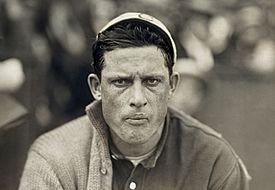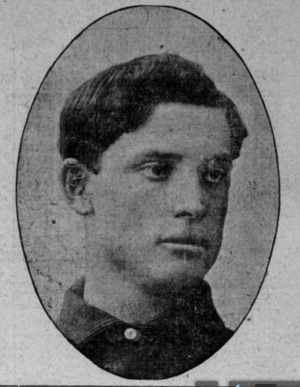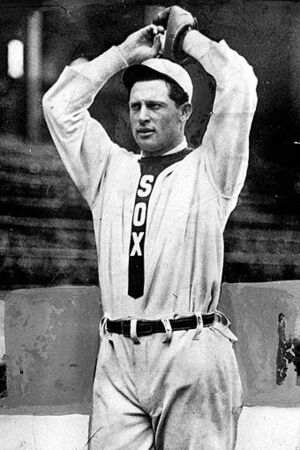Ed Walsh facts for kids
Quick facts for kids Ed Walsh |
|||
|---|---|---|---|

Walsh with the Chicago White Sox in 1911
|
|||
| Pitcher / Manager | |||
| Born: May 14, 1881 Plains Township, Pennsylvania |
|||
| Died: May 26, 1959 (aged 78) Pompano Beach, Florida |
|||
|
|||
| debut | |||
| May 7, 1904, for the Chicago White Sox | |||
| Last appearance | |||
| September 11, 1917, for the Boston Braves | |||
| MLB statistics | |||
| Win–loss record | 195–126 | ||
| Earned run average | 1.82 | ||
| Strikeouts | 1,736 | ||
| Teams | |||
As player
As manager
|
|||
| Career highlights and awards | |||
|
|||
| Induction | 1946 | ||
| Election Method | Veterans Committee | ||
Edward Augustine "Big Ed" Walsh (May 14, 1881 – May 26, 1959) was a famous American pitcher and manager in Major League Baseball (MLB). From 1906 to 1912, he was one of the best pitchers in baseball. Sadly, injuries cut his career short. Walsh still holds the record for the lowest career earned run average (ERA) at 1.82. He is one of only two modern pitchers (since 1901) to win 40 or more games in a single season. He was the last pitcher to achieve this amazing feat. He was also the last pitcher to throw more than 400 innings in one season, which he did in 1908. Ed Walsh was inducted into the Baseball Hall of Fame in 1946.
Contents
Early Life and Baseball Start
Ed Walsh was born in Plains Township, Pennsylvania. His parents were Michael and Jane Walsh. When he was young, he worked in the coal mines of Luzerne County. Walsh began his professional baseball journey with the Wilkes-Barre Barons in 1902. After the 1903 season, the Chicago White Sox bought his contract for $750. This was a big step for his career!
Amazing Baseball Career
His Best Seasons
Walsh made his big league debut in 1904 with the Chicago White Sox. His first full season was in 1906. That year, he won 17 games and lost 13, with an excellent 1.88 ERA. He also had 171 strikeouts. In Game Three of the 1906 World Series, Walsh set a new record by striking out 12 batters. The White Sox won that World Series against the Chicago Cubs.
From 1906 to 1912, Walsh was incredible. He averaged 24 wins and 220 strikeouts each year. His ERA was below 2.00 five times during this period. He also led the league in saves five times. His best year was 1908. He won 40 games and lost only 15! He also had 269 strikeouts and a tiny 1.42 ERA. He led the American League in both wins and strikeouts that year. In 1910, he had the lowest ERA (1.27) for a pitcher with a losing record. Walsh also set an American League record by pitching 464 innings in one season. On August 27, 1911, Walsh pitched a no-hitter against the Boston Red Sox, winning 5–0.
The Famous Spitball
Hall of Famer Sam Crawford once talked about Ed Walsh's special pitch. Walsh used a "spitball," which was a pitch that was later made illegal. Crawford joked that the ball seemed to "disintegrate" on its way to the plate. He said it was like only the spit went by! This shows how tricky and effective Walsh's spitball was.
Comiskey Park's Design
In 1910, the White Sox opened their new stadium, White Sox Park. It was soon called Comiskey Park after the team owner, Charles Comiskey. There's a story that the architect, Zachary Taylor Davis, asked Walsh for advice on the field's size. Walsh supposedly chose a design that helped pitchers, not hitters. This made Comiskey Park known as a "pitcher's park" for its entire 80-year history.
Facing Injuries
Ed Walsh was a "workhorse" pitcher. This means he pitched a lot of innings every year. From 1907 to 1912, he pitched an average of 375 innings annually. After the 1912 season, Walsh wanted a whole year off to rest his arm. But he showed up for spring training the next season anyway. He felt the White Sox needed him to return.
However, Walsh's playing time started to decrease in 1913. Some say he wasn't in as good shape as other pitchers. He tried to keep up with their fast pitches before he was ready. This might have hurt his arm. Walsh later said, "My arm would keep me awake till morning with a pain I had never known before." He pitched only 16 games in 1913. Over the next three years, he played in only 13 games.
By 1916, Walsh's arm was no longer strong. He wanted a year off, but Charles Comiskey released him. He tried to play for the Boston Braves in 1917, but they let him go too. This ended his major league career.
After Playing Baseball
After his playing days, Ed Walsh pitched a bit in the Eastern League. He even tried being an umpire for 87 American League games in 1922. Later, he became a coach for the White Sox for several seasons (1923–1924, 1928–1929).
Walsh finished his career with 195 wins and 126 losses. He had 1736 strikeouts. His career ERA of 1.82 is the lowest ever in Major League Baseball history! He also has the second-lowest career WHIP (Walks plus Hits per Inning Pitched) in MLB history (1.00). This is the lowest for anyone who pitched 10 or more seasons.
As a hitter, Walsh had a .194 batting average. He got 210 hits, scored 92 runs, hit 3 home runs, and had 68 RBI. He also stole 14 bases and got 46 walks.
Managerial Record
| Team | Year | Regular season | Postseason | |||||||
|---|---|---|---|---|---|---|---|---|---|---|
| Games | Won | Lost | Win % | Finish | Won | Lost | Win % | Result | ||
| CWS | 1924 | 3 | 1 | 2 | .333 | interim | – | – | – | – |
| Total | 3 | 1 | 2 | .333 | 0 | 0 | – | |||
Ed Walsh's Legacy
Ed Walsh was inducted into the Baseball Hall of Fame in 1946. He passed away on May 26, 1959, shortly after his 78th birthday.
In 1999, The Sporting News ranked Walsh as number 82 on their list of the 100 Greatest Baseball Players. He was also nominated for the Major League Baseball All-Century Team. In 2011, he was honored by being inducted into the Irish American Baseball Hall of Fame.
Ed Walsh's son, Ed Walsh Jr., also played baseball for the White Sox from 1928 to 1932.
See also
 In Spanish: Ed Walsh para niños
In Spanish: Ed Walsh para niños



